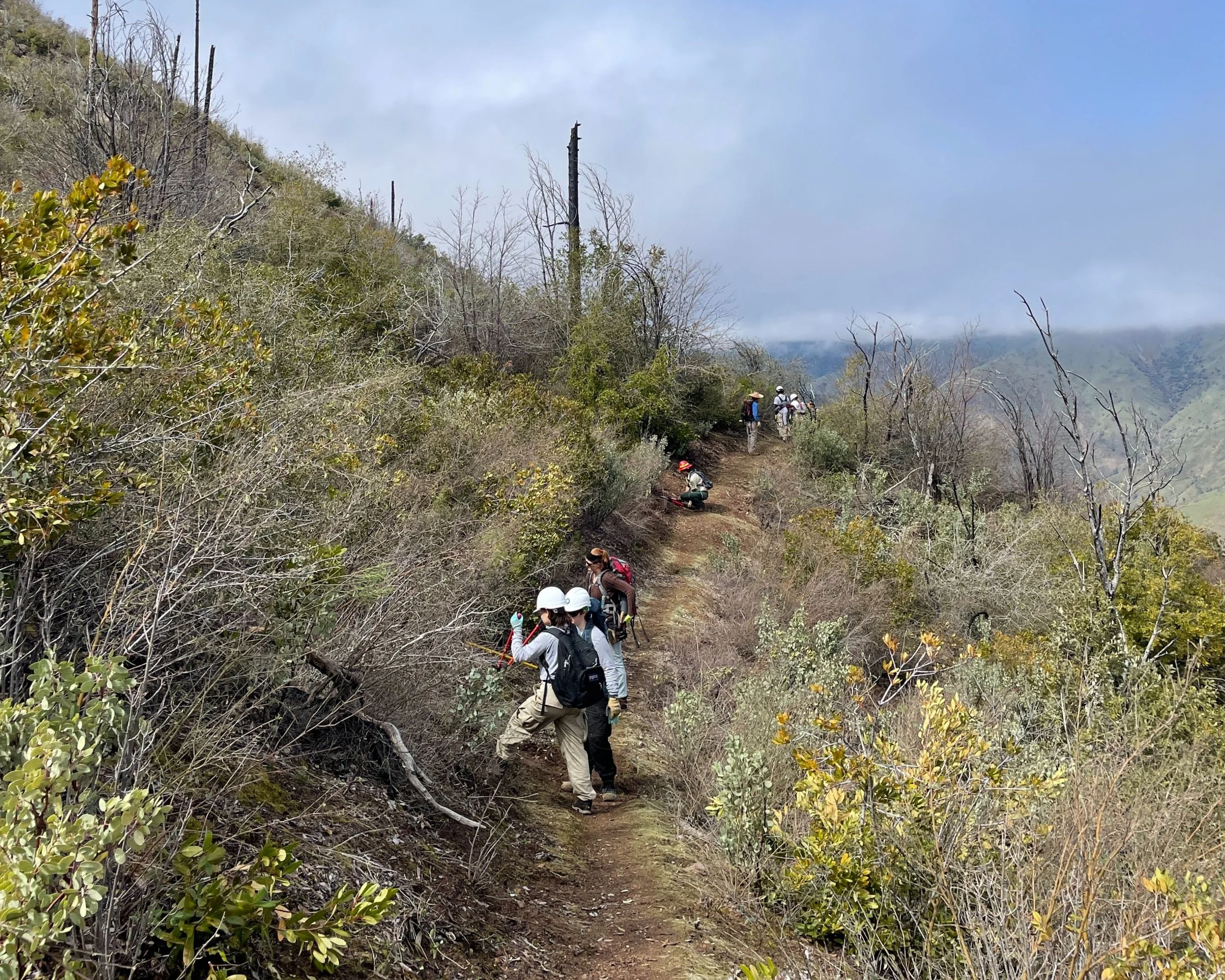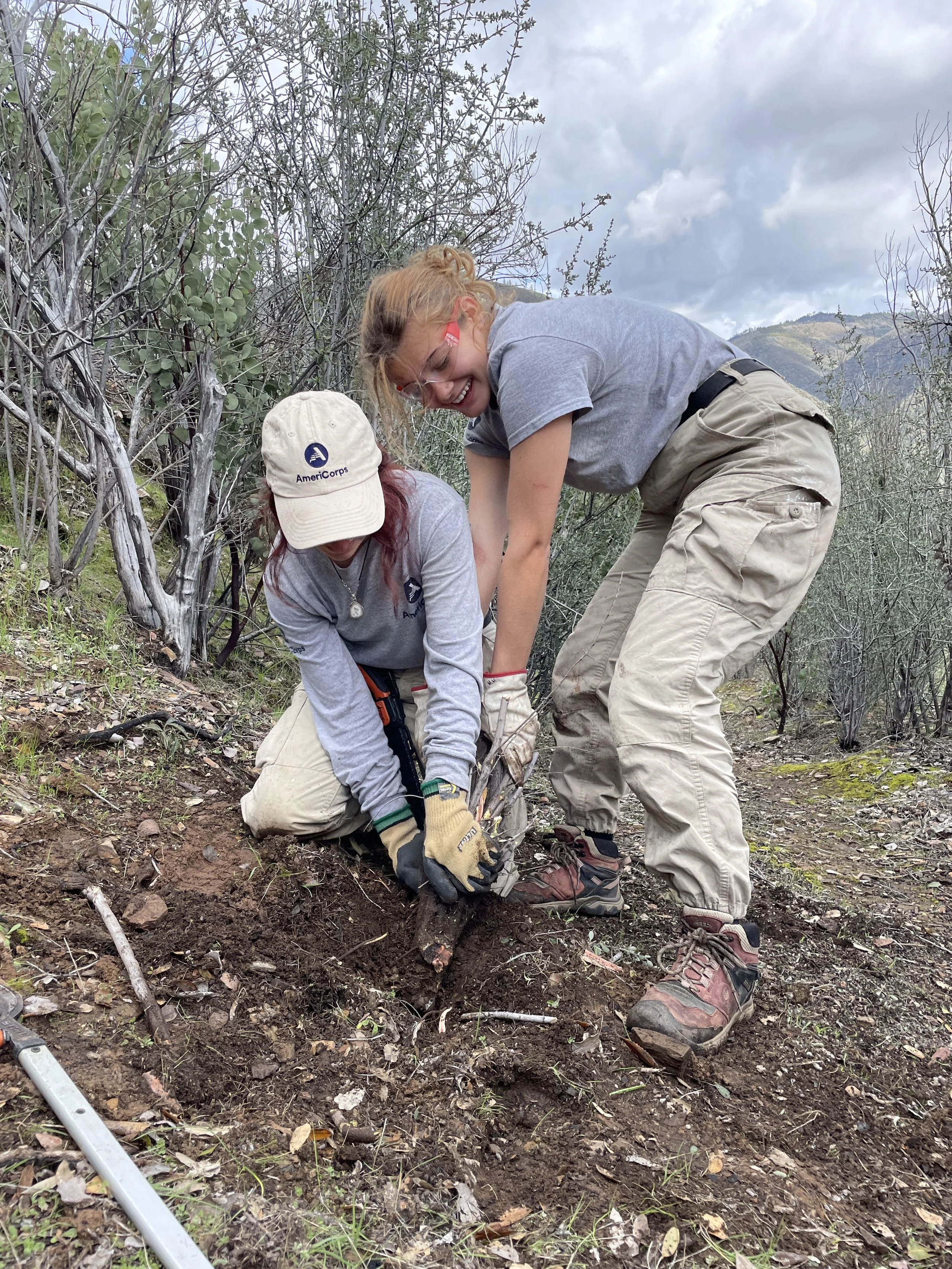Trailblazing with Tuolumne River Trust: A Personal Journey of Restoration & Discovery
by Holly Heath, TRT Restoration Coordinator II
My first trek down the Hamby Trail was nothing short of an initiation into a world where nature’s raw beauty and its vulnerabilities collide. Winding through the Tuolumne River canyon, the trail’s switchbacks offered more than just stunning vistas of the surrounding peaks and the famed Jawbone Ridge; they unfolded a story of a landscape in recovery and a community united in its restoration.
The winter of 2023 had draped Groveland in a heavy snowfall, altering not just the Hamby Trail but also its neighbor, the Indian Creek Trail. The aftermath of the 2013 Rim Fire still lingered, with skeletal remains of trees and shrubs intermittently blocking our path. It was a landscape in recovery, with each step revealing the delicate balance between destruction and regrowth. Waterfalls cascaded down Jawbone Ridge, their music intertwining with the river’s roar, crafting a symphony of natural resilience.
A turning point in our journey of restoration came with the arrival of the Gold-7 unit of the AmeriCorps National Civilian Conservation Corps (NCCC) in the spring of 2023. Their youthful energy was infectious, transforming daunting challenges into milestones of progress. Alex, one of the crew members, became a symbol of our collective effort when he effortlessly cleared a fallen tree, his actions echoing the resolve of everyone involved.
Will, another NCCC member, reflects on his time out working on the trails. “Truly one of my favorite days of service with NCCC was being able to hike down the Hamby trail to the confluence of the Tuolumne and Clavey Rivers and plant trees at the riverside. The day was beautiful, as was the hike, and it was humbling knowing that the trees we planted could serve so many campers, hikers and rafters in the future.”
April brought the American Hiking Society (AHS) into our fold, their ranks bolstered by seasoned hikers whose dedication knew no age. One memorable afternoon, an eighty-year-old volunteer faced down a fallen pine with nothing but a hand saw and a heart full of resolve, supported by the dedicated team from AHS. The collective effort that followed, a blend of sawing and strategic pressure, culminated in a triumphant crack that resonated like a victory cry across the canyon.
Our commitment to the land extended beyond the trails to the very veins of the Tuolumne River itself. Teaming up with one of our river guide collaborators, Sierra Mac River Trips, for a day of rafting and restoration, Cailey and I hurried to plant as many willows as we could as close to the river as possible, so they might survive when the river’s flow dropped dramatically later in the season. The Tuolumne River definitely earned its “Wild” status on that day. Riding the rapids was reminiscent of cresting ocean swells in an approaching storm—they were tall, powerful, and thrilling.
Water flow rates on the Wild and Scenic Tuolumne are regulated by the O’Shaughnessy Dam at Hetch Hetchy Reservoir, which in turn are impacted by the demand for hydroelectric energy. This leads to a river flow that varies widely throughout the course of a day, more so throughout seasons, and restoring the riparian zone has proven a challenge. Willows and other riparian species are best planted during their period of winter dormancy, a practice which minimizes shock and maximizes survival.
Once planted, they need to remain in consistently moist soil to get established. When TRT goes out on an adventurous willow planting excursion, the areas in which willows are planted vary widely based upon the level of the river, which unfortunately leads to low survival rates.
Nonetheless, we persevere. As our knowledge expands; we are experimenting with planting canyon live oaks along the river to help build riparian habitat with a more drought tolerant species. We also plan to continue planting willows and other species and are researching options and seeking input to help the water-loving plants establish on a variable riverbank.
2023 saw a diverse collection of volunteers, from varied walks of life, converge on the trails of the Tuolumne, their dedication woven into the very paths we tread. Steadfast volunteer Sharkey Cornell’s words, reflecting on a day’s work, resonated deeply, encapsulating the essence of our endeavors: “After a day of working on a trail, one goes home with a deep sense of satisfaction on many levels: making things better than they were before, seeing progress as we work through the day, and, of course, getting a good workout in the bargain.”
As we look towards the future, our vision expands beyond the trails we’ve trodden. With the support of the River Network and the National Forest Foundation, we aim to extend our stewardship, inviting more hands to join in our mission of preservation and discovery.




